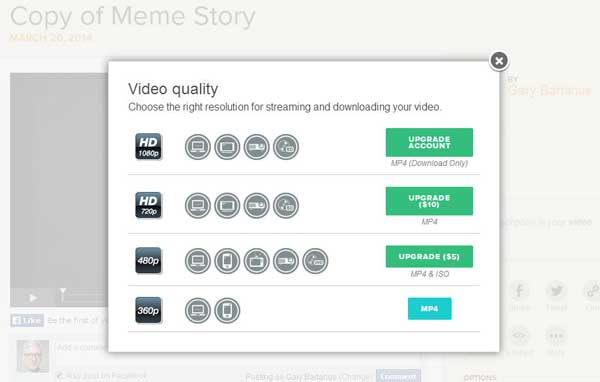Here is the most recent version of my digital story, “My Meme Story”:
The Making of “My Meme Story”
Before beginning production of my digital story, I had roughed out a storyboard with a few basic images and fairly good depictions of myself as a child. (The actual family photos are in storage in Canada.) All the content was carefully screened for Creative Commons licensing according to our required readings (UBC Copyright Requirements and “fair dealing” information) and the advice given at Levine’s site. I then used my storyboard to see how it would work with a new storytelling site called Glossi.com plus some of the resources on Levine’s list. Finally, after viewing several of the exemplar digital stories from previous ETEC565A classes and considering various criteria in the SECTIONS framework, I decided to go forward in my project with Animoto.
In theory, Animoto was a good choice for my digital story because it seemed to fit some of the most relevant criteria in the SECTIONS Framework for my English Writing with Multimedia class at Hanyang University. I had looked at several other digital stories that were made with this application and had been positively impressed with the crisp, colorful imagery, cool animation and the excellent sound. This, I thought, would fulfill the need for “Novelty” and also impress my “Students,” who are generally quite particular about the quality of any multimedia they encounter. Korean internet access, WiFi service, and smartphones are among the most powerful in the world and computer gaming—which demands high quality multimedia—is an extremely popular pastime here, so I thought that Animoto’s multimedia capabilities would be acceptable and perhaps even engaging to my students.
Furthermore, because most of my students have had little or no experience with video editing, I thought Animoto’s alleged “Ease of use and Reliability” would allow me to provide students with more effective and supportive scaffolding as they gradually learn how to edit video and sound into meaningful films. (At the time, I didn’t realize that the cost of its “ease of use” is its frustrating lack of creative control.)
I was also taken in by Animoto’s “Cost” advantage: all free accounts offer 30 seconds of video length, 300+ music tracks and “web quality” video resolution. Furthermore, the company offers instant “Animoto for Education” accounts that are good for a year and allow teachers to enroll classes and get a free upgrade to the “$5/month “Plus” Plan. (With this instant education upgrade, I was also thinking “Speed” was another key criterion that would be met.)
That was the theory.
In practice, Animoto turned out to be one of the most frustrating, time-wasting, and utterly useless pieces of “technology” that I have ever had the misfortune of attempting to use. Finally, after 15 to 20 hours of working with it, I finally had to rescue myself from its clutches and change to something else.
I was able to salvage about 2 minutes of usable footage—but was required to pay $10 just to have the privilege of downloading it in high definition quality. An example of the “web quality” media that comes with the Animoto Education package is embedded further down this page and, if you were to check it out, I am sure you would agree it does not comply with the principle stated by George Siemens that “Media characteristics need to match with the requirements of the learning outcome” and that no self-respecting audiophile (or video producer) would want to use it for long. Under such abysmal conditions, my Students’ expectations for reasonable multimedia quality could never be met.
So far as the “Speed” criterion is concerned, the only thing speedy about Animoto was the instant upgrade to the Animoto for Education package. Everything that followed after that was incredibly slow—and it was not because of my location in Asia. As the clip below shows, Animoto itself admits to taking at least 30 seconds to generate a preview:
The “Cost” criterion also turned out to be misleading. As the free “web quality” video below demonstrates, Animoto must still be fixated on the “web quality” standards that were common in the 1990s. By today’s standards, this is nowhere near “web quality” and, with such nerve-grinding distortion of the audio (especially after the 30 second mark), it is certainly not useable in a university learning environment.
After seeing and hearing how unusable my “web quality” video was, I ended up on this Animoto page:
By the time I got to this point in my Animoto experience, I knew that the best thing I could do would be to download a reasonable quality (720p HD) version of my work, and then continue my project with proven software that would not waste any more of my time, Camtasia Studio by TechSmith.
Once I paid my $10 USD, downloaded the video, and imported it into Camtasia, I discovered that the hideous sound quality was the same as in the “free” Animoto video. Fortunately, I was able to locate and download an mp3 file of the same music and replace the Animoto garble-sounds with it. Following is a 20 second sound sample, selected from the same 10 second section of music in the Desoto Jones song, Don’t Fail Me. The first 10 seconds are Animoto sound and the last 10 seconds are the mp3 file’s sound. Click here to download and compare.
The rest of the story-making process went reasonably well; however, because of the time lost on Animoto, I have not yet been able to produce the English subtitles that will be helpful to my ESL students. I was able to find an Animoto “Style” that provided clear and legible text and a clean (black) background that would afford easier reading for my students . However, the process of finding this was also time-consuming because Animoto’s style previews don’t provide enough information, thereby making it necessary to actually install a potential style, wait 30 or more seconds for the preview to load, and then wait an additional 3 to 4 minutes for the constantly re-buffering preview (of a 2 minute segment) to give you a rough idea of how that 2 minute segment might look/sound in the final video.
For the subject matter of “My Meme Story,” it was necessary to make use of copyrighted materials from YouTube. Because this digital story is purely for educational purposes, I was able to do so under the provisions of the UBC’s Fair Dealing Requirements. However, I was surprised to see that the Animoto music selection was among the content for which I received a YouTube Copyright Notification (which I am disputing according to “fair dealing for educational purposes” provisions). I would have thought that a for-profit website that offers video making services would have proactively settled all potential copyright issues. However, as the Animoto Helpdesk discloses, they do not do any such thing and only offer their customers some detailed advice on how to dispute such notifications, once again costing the user more precious time.
Years ago, I gave up on the notion of saving costs by using all that “free stuff” that floats around the internet and ends up on sites like Levine’s. This project has only reinforced my conviction that most of those “free” online resources are little more than slickly packaged enticements for purchasing upgrades to “plus,” “pro” or “premium” versions that, even after the upgrade, often continue to stifle a user’s creativity (as I discovered with Animoto) and end up costing dearly in terms of both money and, even more significantly, that most precious entity known as time.
References:
Print/Online Sources:
Bates A. W. & Poole, G. (2003). A framework for selecting and using technology. In A.W. Bates & G. Poole, Effective teaching with technology in higher education (pp. 75-108). San Francisco: Jossey-Bass. 4.
Boyes, J., Dowie, S., & Rumzan, I. (2005). Using the SECTIONS framework to evaluate flash media. Innovate Journal of Online Education, 2(1). Retrieved from http://citeseerx.ist.psu.edu/viewdoc/download?doi=10.1.1.186.6505&rep=rep1&type=pdf
Don’t Fail Me by Desoto Jones. (n.d.). Download DON’T FAIL ME by DESOTO JONES. Retrieved March 25, 2014, from http://www.gettyimages.in/music/download-songs/351734-dont-fail-me
Guidelines & Requirements. (n.d.). Copyright at UBC. Retrieved March 25, 2014, from http://copyright.ubc.ca/requirements/
Levine, A. (n.d.). home. 50+Ways –. Retrieved March 18, 2014, from http://50ways.wikispaces.com/
Siemens, G. (2003). Evaluating media characteristics: Using multimedia to achieve learning outcomes. Elearnspace. Retrieved from http://www.elearnspace.org/Articles/mediacharacteristics.htm
YouTube and Facebook Copyright Notifications : Animoto Helpdesk. (n.d.). Animoto Helpdesk. Retrieved March 25, 2014, from http://help.animoto.com/entries/22004941-YouTube-and-Facebook-Copyright-Notifications
YouTube Sources:
50 Web 2.0 Ways to Tell a Story. (2011). Retrieved fromhttps://www.youtube.com/watch?v=kDYJAZiskRw&feature=youtube_gdata_player
An anthropological introduction to YouTube. (2008). Retrieved fromhttps://www.youtube.com/watch?v=TPAO-lZ4_hU&feature=youtube_gdata_player
Baby Gangnam Style (Official Video). (2012). Retrieved fromhttps://www.youtube.com/watch?v=mP1DPTY4Y7o&feature=youtube_gdata_player
Eminem – Love the Way You Lie ft Rihanna Parody: Key of Awesome #27. (2010). Retrieved from https://www.youtube.com/watch?v=6dNryy5elc8&feature=youtube_gdata_player
Eminem – Love The Way You Lie ft. Rihanna. (2010). Retrieved fromhttps://www.youtube.com/watch?v=uelHwf8o7_U&feature=youtube_gdata_player
Eminem – Love The Way You Lie ft. Rihanna Parody – Used To Be a Guy. (2010). Retrieved from https://www.youtube.com/watch?v=8pDy1uEdgkw&feature=youtube_gdata_player
Just for Hits – Richard Dawkins. (2013). Retrieved fromhttps://www.youtube.com/watch?v=GFn-ixX9edg&feature=youtube_gdata_player
Mitt Romney Style (Gangnam Style Parody). (2012). Retrieved fromhttps://www.youtube.com/watch?v=yTCRwi71_ns&feature=youtube_gdata_player
Numa Numa. (2006). Retrieved from https://www.youtube.com/watch?v=60og9gwKh1o&feature=youtube_gdata_player
Numa numa dance and song by Osama Bin laden. (2012). Retrieved fromhttps://www.youtube.com/watch?v=SpgfECsgUHM&feature=youtube_gdata_player
O-Zone – Dragostea Din Tei (Ultra Music). (2007). Retrieved fromhttps://www.youtube.com/watch?v=jRx5PrAlUdY&feature=youtube_gdata_player
PSY – GANGNAM STYLE (강남스타일) M/V. (2012). Retrieved fromhttps://www.youtube.com/watch?v=9bZkp7q19f0&feature=youtube_gdata_player
PSY싸이 – GANGNAM STYLE (강남스타일) Waveya 웨이브야 Korean dance team. (2012). Retrieved from https://www.youtube.com/watch?v=kpZhZAr1cQU&feature=youtube_gdata_player
Spongebob Numa Numa. (2008). Retrieved fromhttps://www.youtube.com/watch?v=oo6djuO94N8&feature=youtube_gdata_player
Sundance – How & Why to Use YouTube Casey Neistat. (2014). Retrieved from https://www.youtube.com/watch?v=qnLMKxuBeCw&feature=youtube_gdata_player
The Machine is Us/ing Us (Final Version). (2007). Retrieved fromhttps://www.youtube.com/watch?v=NLlGopyXT_g&feature=youtube_gdata_player
유세윤 (Yoo Se Yoon) – 까똑 (KKA TTOK) MV. (2013). Retrieved fromhttps://www.youtube.com/watch?v=2S_y_xlmp6c&feature=youtube_gdata_player

